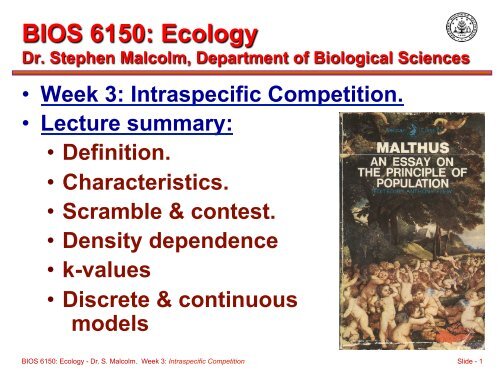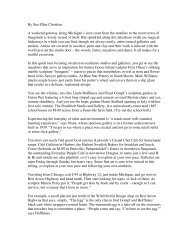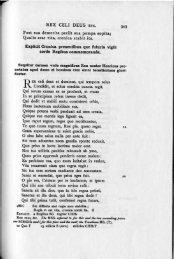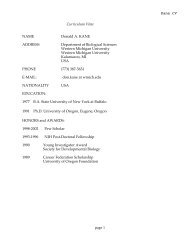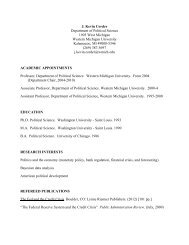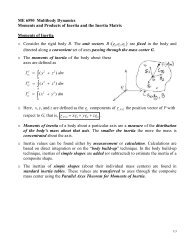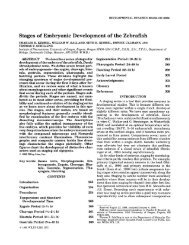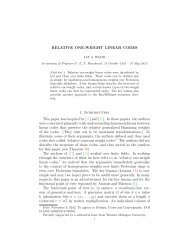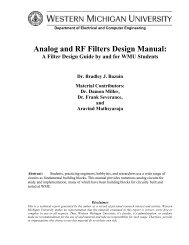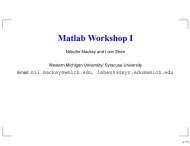Intraspecific Competition.
Intraspecific Competition.
Intraspecific Competition.
Create successful ePaper yourself
Turn your PDF publications into a flip-book with our unique Google optimized e-Paper software.
BIOS 6150: Ecology<br />
Dr. Stephen Malcolm, Department of Biological Sciences<br />
• Week 3: <strong>Intraspecific</strong> <strong>Competition</strong>.<br />
• Lecture summary:<br />
• Definition.<br />
• Characteristics.<br />
• Scramble & contest.<br />
• Density dependence<br />
• k-values<br />
• Discrete & continuous<br />
models<br />
BIOS 6150: Ecology - Dr. S. Malcolm. Week 3: <strong>Intraspecific</strong> <strong>Competition</strong> Slide - 1
2. <strong>Competition</strong>:<br />
• Interactive process.<br />
• Product of combined demand for resources.<br />
• Leads to competition among individuals,<br />
either:<br />
• intraspecifically or,<br />
• interspecifically.<br />
• Results in a negative outcome for all<br />
competitors.<br />
BIOS 6150: Ecology - Dr. S. Malcolm. Week 3: <strong>Intraspecific</strong> <strong>Competition</strong> Slide - 2
3. Definition of <strong>Competition</strong>:<br />
• “competition is an interaction between<br />
individuals, brought about by a shared<br />
requirement for a resource [in limited supply],<br />
and leading to a reduction in the survivorship,<br />
growth and/or reproduction of at least some of<br />
the competing individuals concerned”<br />
(Begon et al., 2006, p. 132)<br />
• The ultimate effect of competition on an individual is a<br />
decreased fitness contribution to the next generation<br />
(fewer offspring) compared with what would have<br />
happened had there been no competitors.<br />
BIOS 6150: Ecology - Dr. S. Malcolm. Week 3: <strong>Intraspecific</strong> <strong>Competition</strong> Slide - 3
4. Four characteristics of intraspecific<br />
competition:<br />
• (1) Decrease in fitness:<br />
• The ultimate effect of competition is a decrease in the fitness of all<br />
interactants (thus it is a “-,-” interaction):<br />
• Often via decreased survivorship or fecundity.<br />
• Fitness reduction must be measurable to conclude that competition occurred.<br />
• (2) Limited supply of resources:<br />
• The resource for which individuals compete must be in limited supply.<br />
• (3) Reciprocity:<br />
• Even if the detectable competition is either mostly one-sided, or<br />
balanced, it must be reciprocal and have a negative impact on both<br />
interactants (symmetrical and asymmetrical).<br />
• (4) Density dependence:<br />
• The probability of an individual being adversely affected increases with<br />
increasing competitor density (in contrast to density independent effects).<br />
BIOS 6150: Ecology - Dr. S. Malcolm. Week 3: <strong>Intraspecific</strong> <strong>Competition</strong> Slide - 4
5. Extremes of intraspecific competition:<br />
• Scramble (exploitation) and contest<br />
(interference) competition were first<br />
described as simplistic extremes by<br />
Nicholson (1954) in Australia.<br />
• Mortality (% or k competition due to competition) or<br />
survivorship is plotted against logarithm of initial<br />
density to show degree of density dependence.<br />
BIOS 6150: Ecology - Dr. S. Malcolm. Week 3: <strong>Intraspecific</strong> <strong>Competition</strong> Slide - 5
6. Scramble & Contest <strong>Competition</strong>:<br />
• Scramble competition:<br />
• Nicholson described scramble competition for dungflies<br />
competing for the limited resources of cow feces.<br />
• Each member gathers a constant amount of resource at all densities.<br />
Thus at high density there is insufficient resource and the whole<br />
population dies (slope b = ∞).<br />
• Contest competition:<br />
• Where individuals of the population interfere or contest with<br />
each others abilities to harvest resources, some survive.<br />
• Exact density-dependent compensation is thus described by a<br />
mortality slope b = 1.<br />
• Figs. 5.1 & 5.2 from Begon et al. (2006) to show both kinds and<br />
negative effects of competition in single species populations.<br />
BIOS 6150: Ecology - Dr. S. Malcolm. Week 3: <strong>Intraspecific</strong> <strong>Competition</strong> Slide - 6
7. Density dependence:<br />
• <strong>Competition</strong> also increases with population<br />
density when mortality may increase or<br />
survivorship may decrease (Fig. 5.2).<br />
• The nature of density dependence can also<br />
change with increasing density from:<br />
• density independence, through,<br />
• undercompensating density dependence, to,<br />
• exactly compensating density dependence, to,<br />
• overcompensating density dependence<br />
(Figs 5.3, 5.4 & 6.5).<br />
BIOS 6150: Ecology - Dr. S. Malcolm. Week 3: <strong>Intraspecific</strong> <strong>Competition</strong> Slide - 7
8. Density dependence (continued):<br />
• So intensities of both kinds of intraspecific<br />
competition increase with population density and<br />
change from density independence to density<br />
dependence.<br />
• Thus density dependent birth and mortality rates lead to<br />
the regulation of population size at a stable equilibrium<br />
where births = deaths.<br />
• This is the carrying capacity (K) at the population size<br />
sustainable by available resources as shown in Figs. 5.7 & 5.8.<br />
• Density dependent population regulation generates the<br />
sigmoidal or S-shaped curve characteristic of intraspecific<br />
competition (see Fig 5.11).<br />
BIOS 6150: Ecology - Dr. S. Malcolm. Week 3: <strong>Intraspecific</strong> <strong>Competition</strong> Slide - 8
9. Density dependent growth:<br />
• In addition to effects on numbers, competition also<br />
negatively influences growth:<br />
• This in turn influences numbers through reduced per capita<br />
reproductive output.<br />
• Rates of growth and rates of development can be reduced<br />
as shown in Figs 6.14 & 5.12:<br />
• But the total population biomass can remain the same, despite<br />
individuals being smaller:<br />
• The “law of constant final yield” (exact compensation)<br />
• Reproductive allocation can also shift with changing<br />
resource availability (Figs. 6.16 & 5.15):<br />
• Within genets, tiller growth was less variable and more regulated<br />
than the genets themselves.<br />
BIOS 6150: Ecology - Dr. S. Malcolm. Week 3: <strong>Intraspecific</strong> <strong>Competition</strong> Slide - 9
10. k-values and density dependent<br />
mortality:<br />
• k-values of mortality due to competition can define competition<br />
according to the slope b of the relationship (Fig. 5.16) of<br />
k competition plotted against the logarithm of initial density<br />
(density before the effects of competition).<br />
• b = 0 density independence.<br />
• b < 1 undercompensating density dependence.<br />
• b = 1 (contest) exact density dependent compensation.<br />
• b > 1 overcompensating density dependence<br />
• b = ∞ (scramble) overcompensating density dependence<br />
• see Fig. 2-3 from Hassell (1976) of scramble and contest competition.<br />
• k-mortality is shown in Fig 5.16 & k-fecundity in Fig. 6.20.<br />
BIOS 6150: Ecology - Dr. S. Malcolm. Week 3: <strong>Intraspecific</strong> <strong>Competition</strong> Slide - 10
11. Discrete breeding season model of<br />
intraspecific competition:<br />
• Using:<br />
• R net reproductive rate<br />
• N t population size at time t<br />
• N t+1 population size at time t+1<br />
• In the absence of competition, the model describes<br />
population increase simply as:<br />
• N t+1 = N t R and<br />
• N t = N o R t<br />
• This gives the exponential population growth across discrete<br />
generations as in Fig. 5.18.<br />
BIOS 6150: Ecology - Dr. S. Malcolm. Week 3: <strong>Intraspecific</strong> <strong>Competition</strong> Slide - 11
12. Carrying capacity, limited resources<br />
and the effect of competition:<br />
• At high density when the ratio of N t /N t+1 = 1 this is<br />
by definition the carrying capacity K.<br />
• So in the presence of competition, the population<br />
rises to K as shown in Fig. 5.18.<br />
• according to:<br />
• N t+1 = N t R/1+(aN t )<br />
• where a = (R-1)/K<br />
• so the unrealistic R in the first equation is now replaced by<br />
the more realistic R/(1 + aN t )<br />
• as a and N t increase so does the effect of competition and R<br />
is decreased.<br />
BIOS 6150: Ecology - Dr. S. Malcolm. Week 3: <strong>Intraspecific</strong> <strong>Competition</strong> Slide - 12
13. Density dependence of the model:<br />
• The k-value for mortality<br />
due to competition is<br />
thus the difference<br />
between log N t R and<br />
log N t R/(1+aN t ) and<br />
plotting these k values<br />
against log 10 N t (Fig.<br />
5.20) shows that the<br />
model exactly<br />
compensates with a<br />
slope b = 1.<br />
BIOS 6150: Ecology - Dr. S. Malcolm. Week 3: <strong>Intraspecific</strong> <strong>Competition</strong> Slide - 13
14. Incorporation of variable density<br />
dependence with b:<br />
• A more realistic model of competition that<br />
incorporates a range of competitive regulation was<br />
derived by Maynard Smith & Slatkin (1973) in<br />
which they simply added the slope b of the k-value<br />
plotted against log initial density:<br />
• Nt+1 = NtR/1+(aNt ) b<br />
• in which b is the slope of mortality (k) against<br />
population size (log10Nt ) and,<br />
• a substitutes for (R-1)/K as before<br />
(see Figs. 5.21 & 6.26 for real data).<br />
• Also generates realistic ranges of population<br />
fluctuations (Fig. 5.22).<br />
--- equation 5.18 (p.148)<br />
BIOS 6150: Ecology - Dr. S. Malcolm. Week 3: <strong>Intraspecific</strong> <strong>Competition</strong> Slide - 14
15. Continuous breeding - the logistic equation:<br />
• The model above was for discrete time steps described by a<br />
“difference” equation.<br />
• For continuously breeding populations (birth and death<br />
continuous) we need a continuous form of the model using a<br />
“differential” equation.<br />
• So for exponential population increase the rate of population<br />
increase is dN/dt and this speed of change is described in<br />
the absence of competition by:<br />
• dN/dt = rN<br />
• where r is the intrinsic rate of natural increase which is lnR or lnR o /T<br />
• So the continuous equivalent to Fig. 5.18 is shown in Fig. 5.23 and<br />
this is the differential form of the difference equation N t = N o R t<br />
BIOS 6150: Ecology - Dr. S. Malcolm. Week 3: <strong>Intraspecific</strong> <strong>Competition</strong> Slide - 15
16. Logistic limitation to a carrying capacity:<br />
• The differential form of N t+1 = N t R/1+(aN t ) in<br />
Fig 5.18 is given by:<br />
dN/dt = rN((K - N)/K)<br />
• This is the famous logistic equation.<br />
• This shows that exponential increase is<br />
decreased to K by the logistic term (K - N)/K<br />
BIOS 6150: Ecology - Dr. S. Malcolm. Week 3: <strong>Intraspecific</strong> <strong>Competition</strong> Slide - 16
17. Asymmetrical competition:<br />
• Large vs small Impatiens in a woodland<br />
(Fig. 5.26):<br />
• Small plants did not grow and so the asymmetry<br />
increased with time.<br />
• Root vs shoot competition in morning glory<br />
Fig. 5.27 (Weiner expt.):<br />
• Root competition for nutrients resulted in most<br />
biomass reduction, but shoot competition for<br />
light generated most size inequality and increase<br />
in asymmetry.<br />
BIOS 6150: Ecology - Dr. S. Malcolm. Week 3: <strong>Intraspecific</strong> <strong>Competition</strong> Slide - 17
Figure 5.1: <strong>Intraspecific</strong> competition among cave<br />
beetles for cave cricket eggs (a) scramble or<br />
exploitation, (b) contest or interference.<br />
BIOS 6150: Ecology - Dr. S. Malcolm. Week 3: <strong>Intraspecific</strong> <strong>Competition</strong> Slide - 18
Figure 5.2: Survivorship of red deer on the island of<br />
Rhum declines with lower birth rate and increased<br />
density.<br />
BIOS 6150: Ecology - Dr. S. Malcolm. Week 3: <strong>Intraspecific</strong> <strong>Competition</strong> Slide - 19
Figure 5.3:<br />
Density dependent mortality in flour beetles changes from (1) density<br />
independence, to (2) undercompensating density dependence, to (3)<br />
overcompensating density dependence.<br />
BIOS 6150: Ecology - Dr. S. Malcolm. Week 3: <strong>Intraspecific</strong> <strong>Competition</strong> Slide - 20
Figure 5.4: Exact compensation in trout fry.<br />
BIOS 6150: Ecology - Dr. S. Malcolm. Week 3: <strong>Intraspecific</strong> <strong>Competition</strong> Slide - 21
Figure 6.5 (3 rd ed.): Density dependent mortality in<br />
soybeans leading to overcompensation with time.<br />
BIOS 6150: Ecology - Dr. S. Malcolm. Week 3: <strong>Intraspecific</strong> <strong>Competition</strong> Slide - 22
Figure 5.7: Density dependent birth and<br />
mortality rates.<br />
BIOS 6150: Ecology - Dr. S. Malcolm. Week 3: <strong>Intraspecific</strong> <strong>Competition</strong> Slide - 23
Figure 5.8:<br />
Differences between births and deaths (a), generate recruitment (b),<br />
and population increase to a carrying capacity (c).<br />
BIOS 6150: Ecology - Dr. S. Malcolm. Week 3: <strong>Intraspecific</strong> <strong>Competition</strong> Slide - 24
Figure 5.11:<br />
Examples of S-shaped population increase for (a) Rhizopertha<br />
beetles on wheat, (b) wildebeest after a rinderpest outbreak, and (c)<br />
willows after myxomatosis killed rabbit herbivores.<br />
BIOS 6150: Ecology - Dr. S. Malcolm. Week 3: <strong>Intraspecific</strong> <strong>Competition</strong> Slide - 25
Figure 6.14 (3 rd ed.):<br />
Effects of density on growth rate and size in (a) Rana tigrina frogs<br />
and (b) reindeer.<br />
BIOS 6150: Ecology - Dr. S. Malcolm. Week 3: <strong>Intraspecific</strong> <strong>Competition</strong> Slide - 26
Figure 5.12: Effects of intraspecific competition on growth and<br />
final biomass of populations of the limpet Patella cochlear.<br />
BIOS 6150: Ecology - Dr. S. Malcolm. Week 3: <strong>Intraspecific</strong> <strong>Competition</strong> Slide - 27
Figure 6.16 (3 rd ed. – see Fig. 5.14, 4 th ed.):<br />
“Constant final yield”<br />
of plants sown at a<br />
range of densities<br />
for (a) subterranean<br />
clover, (b, c) the<br />
dune annual Vulpia<br />
fasciculata.<br />
BIOS 6150: Ecology - Dr. S. Malcolm. Week 3: <strong>Intraspecific</strong> <strong>Competition</strong> Slide - 28
Figure 5.15: <strong>Intraspecific</strong> competition in rye<br />
grass regulates the number of modules (tillers).<br />
BIOS 6150: Ecology - Dr. S. Malcolm. Week 3: <strong>Intraspecific</strong> <strong>Competition</strong> Slide - 29
Figure 5.16:<br />
k-values to describe<br />
variable density<br />
dependent mortality in<br />
(a) a dune annual, (b)<br />
almond moth, (c) fruit<br />
fly, and (d) the moth<br />
Plodia interpunctella.<br />
BIOS 6150: Ecology - Dr. S. Malcolm. Week 3: <strong>Intraspecific</strong> <strong>Competition</strong> Slide - 30
Figure 2.3: (Hassell, 1976)<br />
BIOS 6150: Ecology - Dr. S. Malcolm. Week 3: <strong>Intraspecific</strong> <strong>Competition</strong> Slide - 31
Figure 6.20, 3 rd ed., see Fig. 5.17, 4 th ed.):<br />
k-values to describe<br />
density dependent<br />
reductions in<br />
fecundity in<br />
(a) limpets,<br />
(b) cabbage root fly,<br />
(c) grass mirid, and<br />
(d) plantain.<br />
BIOS 6150: Ecology - Dr. S. Malcolm. Week 3: <strong>Intraspecific</strong> <strong>Competition</strong> Slide - 32
Figure 5.18: Difference equation model to describe<br />
population increase in species with discrete generations.<br />
BIOS 6150: Ecology - Dr. S. Malcolm. Week 3: <strong>Intraspecific</strong> <strong>Competition</strong> Slide - 33<br />
11<br />
12<br />
16
Figure 5.21: Different intensities of intraspecific<br />
competition incorporated in equation 6.19.<br />
BIOS 6150: Ecology - Dr. S. Malcolm. Week 3: <strong>Intraspecific</strong> <strong>Competition</strong> Slide - 34
Figure 6.26 (3 rd ed.):<br />
Equation 5.18 fitted<br />
to data for different<br />
beetle species in the<br />
laboratory (a, b, c &<br />
e), and winter moths<br />
in the field (d).<br />
BIOS 6150: Ecology - Dr. S. Malcolm. Week 3: <strong>Intraspecific</strong> <strong>Competition</strong> Slide - 35
Figure 5.22: Range of population fluctuations for<br />
(a) values of b and R and (b) population size against<br />
time, generated by equation 6.19.<br />
BIOS 6150: Ecology - Dr. S. Malcolm. Week 3: <strong>Intraspecific</strong> <strong>Competition</strong> Slide - 36
Figure 5.23: Exponential and sigmoidal models of<br />
population increase against time for continuous breeding<br />
- the logistic model of population growth.<br />
BIOS 6150: Ecology - Dr. S. Malcolm. Week 3: <strong>Intraspecific</strong> <strong>Competition</strong> Slide - 37
Figure 5.26:<br />
Asymmetric<br />
competition in the<br />
woodland plant<br />
Impatiens pallida in<br />
SE Pennsylvania.<br />
BIOS 6150: Ecology - Dr. S. Malcolm. Week 3: <strong>Intraspecific</strong> <strong>Competition</strong> Slide - 38
Figure 5.27: Root vs shoot competition in<br />
morning glory vines, Ipomoea tricolor.<br />
BIOS 6150: Ecology - Dr. S. Malcolm. Week 3: <strong>Intraspecific</strong> <strong>Competition</strong> Slide - 39


